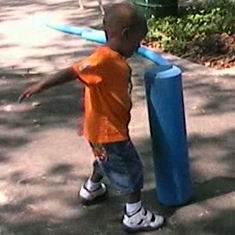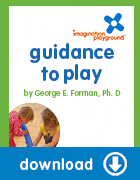In effect, the foam increases the range of play that you will see on the playground.
The large-scale, light-weight, resilient, and soft blocks make it possible for the children to experiment without worry.

The foam blocks do not break when they fall. This young boy stands the cylinder on end, bats it over, and then stands it up to bat again. The foam cylinder gives the child a way to focus some diffuse energy.

Would this boy have created this tall totem if the blocks were made of wood or plastic? The foam allows children to take risks and experiment with even unstable structures.
What It Means
Look for cases where children make extra-tall or extra-tipsy structures just to discover the limits of support. Finding the fall limits of structures help children think about the dynamics of structure, the directional lines of force and support, rather than only thinking about the form or arrangement as a static visual whole. Look for cases where high-energy games are able to proceed without worry because of the foam. Some children will find action play more interesting than building.
2-4 Year Olds
The foam has relevance in different ways for children of different ages. For the youngest ages, the foam offers both surprise and comfort. The children are surprised that something so large can be so light. This size-weight illusion will cause the youngest children to carry the blocks around and sort of adopt blocks that are their size. Carrying or standing the blocks on end give them a sense of confidence, command, and power. The softness of the foam also causes the children to personify some of the blocks, like pets or babies.
4-7 Year Olds
For the older children the foam will help them relax and experiment with unusual structures. They will be surprised by the strength of the blocks, such as when they sit on a seesaw they or someone else made. You may find they deliberately knock down walls or rooms they have made as part of a pretend game of “attack the fort,” knowing that the parts will not break.
7-10 Year Olds
A still older group will take advantage of the foam to work in close quarters as they collaborate, or to use the foam as props for action games such as jumping over a noodle hurdle or bowling over an array of upright Plugs with another Plug or the Little Cheeseblock.
This material is adapted from the publication “Imagination Playground’s Guidance to Play” by George E. Forman, PhD, Emeritus Professor, University of Massachusetts (Amherst) and President of Videatives, Inc.
Dr. Forman has over 33 years of experience in university teaching, cognitive research, multimedia design and educational consulting in the area of early childhood learning and development.
“Guidance to Play” covers 20 topics that help illustrate the significance in what children are doing as they play as well as concrete actions Play Associates can take to facilitate positive behaviors.



